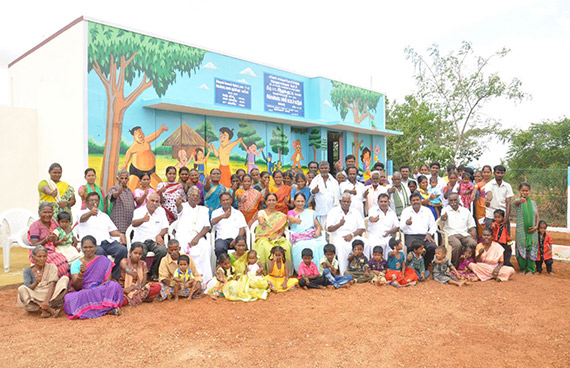Senkadu Play School
Our Story
Our village has 416 people and a government-constructed Anganwadi or pre-school that was outside the village. It was in a low-lying area with no road for access. Neither did it have a boundary wall for safety. And a ditch at the entrance used to get filled up with water in the rainy season, said A. Gomathi, whose four-year-old son now attends the school, but in the early days avoided the place.
SST stepped in and began its efforts by bringing together people for meetings. This, in turn, led to the decision to improve the building and conditions of the school.
Everyone in the village contributed as did SST with funding. Truckloads of mud was used to cover the ditch, trees were planted, the walls were painted and a kitchen garden was also created to make the school an inviting place for children.
“Earlier we had to carry water from our homes to use in the toilets, while today we have water for toilets and for cooking meals for the children,’’ says P. Krishnaveni, who has been working for five years in this school.
The drawings and pictures painted on the walls of the school with fruits, national leaders etc. have caught the interest of children, including children who are walking by, she says. ‘’The kitchen garden is also an interesting way to teach children about their food.’’
The number of children attending school has gone up following the transformation. ‘’I feel motivated to teach and take care of their needs,’’ said Krishnaveni.
Also, about 12 parents come for the monthly Parents Teacher meeting. Parents now prepare a schedule and three to four parents by rotation volunteer to pick up and drop children at their respective homes and look after them when they are in the school. ‘’I do this three times a week,’’ said Gomathi.
The SST Way
Community Development Officer A. Balasubramanian who worked along with the villagers to make this school the heart of the community
Villagers here were up against all odds. The anganwadi and the village were one of the poorest in terms of facilities in this area. We were up for a challenge, so we chose Senkadu, out of a total of 21 such villages, as the first project.
Only five children came to school, and attendance was erratic. The outlook for enrolling more children was bleak. Together with the help of the villagers, we decided to begin by fixing the approach to the school building.
Aside from a 60-feet ditch, people had to also cross a burial ground to reach the building. It was a long list of hurdles. All these issues needed to be sorted along with basic needs such as drinking water, proper toilet and electricity.
For funding, the villagers contributed Rs. 22,000, while SST contributed Rs. 143,000 to take the total corpus to Rs. 165,000. We began the work which was completed in stages. We can’t believe the transformation and the positive energy it has triggered. There are now 16 children enrolled in the school.
As this is a dry area with little agriculture, most people in the 150 houses are daily wage labourers engaged in construction, dyeing, metal grinding and pressing industries.
They, therefore, had to go far from their dwellings to work and, supervision of children posed a challenge. The thriving play school, however, has enthused the community and parents to take turns to take care of these children.
Our Takeaways
Resources, including ideas, inspiration and funds, may all be within reach but mobilisation is key.
It is important to identify the most needy and focus on working to ensure the benefits of development reach them.
Effective targeting of programs is key to achieving maximum impact.
